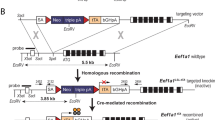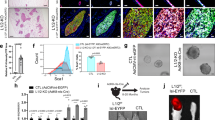Abstract
The Wnt/β-catenin signaling pathway controls cell fate and neoplastic transformation. Expression of an endogenous stabilized β-catenin (ΔE3 β-catenin) in mammary epithelium leads to the transdifferentiation into epidermis- and pilar-like structures. Signaling molecules in the canonical Wnt pathway upstream from β-catenin induce glandular tumors but it is not clear whether they also cause squamous transdifferentiation. To address this question we have now investigated mammary epithelium from transgenic mice that express activating molecules of the Wnt pathway: Wnt10b, Int2/Fgf3, CK2α, ΔE3 β-catenin, Cyclin D1, and dominant negative (dn) GSK3β. Cytokeratin 5 (CK5), which is expressed in both mammary myoepithelium and epidermis, and the epidermis-specific CK1 and CK6 were used as differentiation markers. Extensive squamous metaplasias and widespread expression of CK1 and CK6 were observed in ΔE3 β-catenin transgenic mammary tissue. Wnt10b and Int2 transgenes also induced squamous metaplasias, but expression of CK1 and CK6 was sporadic. While CK5 expression in Wnt10b transgenic tissue was still confined to the lining cell layer, its expression in Int2 transgenic tissue was completely disorganized. In contrast, cytokeratin expression in CK2α, dnGSK3β and Cyclin D1 transgenic mammary tissues was similar to that in ΔE3 β-catenin tissue. In support of transdifferentiation, expression of hard keratins specific for hair and nails was observed in pilar tumors. These results demonstrate that the activation of Wnt signaling components in mammary epithelium induces not only glandular tumors but also squamous differentiation, possibly by activating LEF-1, which is expressed in normal mammary epithelium.
This is a preview of subscription content, access via your institution
Access options
Subscribe to this journal
Receive 50 print issues and online access
$259.00 per year
only $5.18 per issue
Buy this article
- Purchase on Springer Link
- Instant access to full article PDF
Prices may be subject to local taxes which are calculated during checkout





Similar content being viewed by others
References
Aberle H, Bauer A, Stappert J, Kispert A, Kemler R . 1997 EMBO J. 16: 3797–3804
Barker N, Huls G, Korinek V, Clevers H . 1999 Am. J. Pathol. 154: 29–35
Beavon IR . 2000 Eur. J. Cancer 36: 1607–1620
Behrens J, Jerchow BA, Wurtele M, Grimm J, Asbrand C, Wirtz R, Kuhl M, Wedlich D, Birchmeier W . 1998 Science 280: 596–599
Behrens J, von Kries JP, Kuhl M, Bruhn L, Wedlich D, Grosschedl R, Birchmeier W . 1996 Nature 382: 638–642
Bhanot P, Brink M, Samos CH, Hsieh JC, Wang Y, Macke JP, Andrew D, Nathans J, Nusse R . 1996 Nature 382: 225–230
Cadigan KM, Nusse R . 1997 Genes Dev. 11: 3286–3305
Cook D, Fry MJ, Hughes K, Sumathipala R, Woodgett JR, Dale TC . 1996 EMBO J. 15: 4526–4536
Fuchs E, Byrne C . 1994 Curr. Opin. Genet. Dev. 4: 725–736
Harada N, Miyoshi H, Murai N, Oshima H, Tamai Y, Oshima M, Taketo MM . 2002 Cancer Res. 62: 1971–1977
Harada N, Tamai Y, Ishikawa T, Sauer B, Takaku K, Oshima M, Taketo MM . 1999 EMBO J. 18: 5931–5942
He TC, Sparks AB, Rago C, Hermeking H, Zawel L, da Costa LT, Morin PJ, Vogelstein B, Kinzler KW . 1998 Science 281: 1509–1512
Huelsken J, Vogel R, Erdmann B, Cotsarelis G, Birchmeier W . 2001 Cell 105: 533–545
Imbert A, Eelkema R, Jordan S, Feiner H, Cowin P . 2001 J. Cell Biol. 153: 555–568
Klint P, Claesson-Welsh L . 1999 Front Biosci. 4: D165–D177
Korinek V, Barker N, Moerer P, van Donselaar E, Huls G, Peters PJ, Clevers H . 1998 Nat. Genet. 19: 379–383
Kwan H, Pecenka V, Tsukamoto A, Parslow TG, Guzman R, Lin TP, Muller WJ, Lee FS, Leder P, Varmus HE . 1992 Mol. Cell. Biol. 12: 147–154
Landesman-Bollag E, Romieu-Mourez R, Song DH, Sonenshein GE, Cardiff RD, Seldin DC . 2001 Oncogene 20: 3247–3257
Lane TF, Leder P . 1997 Oncogene 15: 2133–2144
Lee FS, Lane TF, Kuo A, Shackleford GM, Leder P . 1995 Proc. Natl. Acad. Sci. USA 92: 2268–2272
Lynch MH, O'Guin WM, Hardy C, Mak L, Sun TT . 1986 J. Cell Biol. 103: 2593–2606
Merrill BJ, Gat U, DasGupta R, Fuchs E . 2001 Genes Dev. 15: 1688–1705
Mester J, Wagenaar E, Sluyser M, Nusse R . 1987 J. Virol. 61: 1073–1078
Michaelson JS, Leder P . 2001 Oncogene 20: 5093–5099
Miller JR, Moon RT . 1996 Genes Dev. 10: 2527–2539
Miyoshi K, Shillingford JM, Le Provost F, Gounari F, Bronson R, von Boehmer H, Taketo MM, Cardiff RD, Hennighausen L, Khazaie K . 2002 Proc. Natl. Acad. Sci. USA 99: 219–224
Moser AR, Mattes EM, Dove WF, Lindstrom MJ, Haag JD, Gould MN . 1993 Proc. Natl. Acad. Sci. USA 90: 8977–8981
Muller WJ, Lee FS, Dickson C, Peters G, Pattengale P, Leder P . 1990 EMBO J. 9: 907–913
Niemann C, Owens DM, Huelsken J, Birchmeier W, Watt FM . 2002 Development 129: 95–109
Peters G, Lee AE, Dickson C . 1984 Nature 309: 273–275
Peters G, Lee AE, Dickson C . 1986 Nature 320: 628–631
Polakis P . 2000 Genes Dev. 14: 1837–1851
Roose J, Huls G, van Beest M, Moerer P, van der Horn K, Goldschmeding R, Logtenberg T, Clevers H . 1999 Science 285: 1923–1926
Rosner A, Miyoshi K, Landesman-Bollag E, Xu X, Seldin DC, Moser AR, MacLeod CL, Shyamala G, Gillgrass AE, Cardiff RD . 2002 Am. J. Pathol. in press
Shtutman M, Zhurinsky J, Simcha I, Albanese C, D'Amico M, Pestell R, Ben-Ze'ev A . 1999 Proc. Natl. Acad. Sci. USA 96: 5522–5527
Song DH, Sussman DJ, Seldin DC . 2000 J. Biol. Chem. 275: 23790–23797
Stewart TA, Pattengale PK, Leder P . 1984 Cell 38: 627–637
Tekmal RR, Keshava N . 1997 Front Biosci. 2: D519–D526
Tetsu O, McCormick F . 1999 Nature 398: 422–426
Tsukamoto AS, Grosschedl R, Guzman RC, Parslow T, Varmus HE . 1988 Cell 55: 619–625
van der Houven van Oordt CW, Smits R, Williamson SL, Luz A, Khan PM, Fodde R, van der Eb AJ, Breuer ML . 1997 Carcinogenesis 18: 2197–2203
Vasioukhin V, Bauer C, Degenstein L, Wise B, Fuchs E . 2001 Cell 104: 605–617
Wang TC, Cardiff RD, Zukerberg L, Lees E, Arnold A, Schmidt EV . 1994 Nature 369: 669–671
Weiss RA, Eichner R, Sun TT . 1984 J. Cell Biol. 98: 1397–1406
Willert K, Brink M, Wodarz A, Varmus H, Nusse R . 1997 EMBO J. 16: 3089–3096
Wodarz A, Nusse R . 1998 Annu. Rev. Cell. Dev. Biol. 14: 59–88
Acknowledgements
We thank Philip Leder for tissue specimen and T-T Sun for the antibody AE13. Part of this work was supported by grants from the Ministry of Education, Science, Sports and Culture and from the Organization for Pharmaceutical Safety and Research, Japan (MM Taketo), by a grant from NIEHS P01 ES11624 (DC Seldin), by a grant from the German Academic Exchange Service (A Rosner) and by grants 5JB-0014 from the State of California Breast Cancer Research Program (RD Cardiff) and U42 RR14905 from the National Institutes of Health, National Centers for Research Resources (RD Cardiff). The authors wish to acknowledge the excellent technical support provided by Judy E Walls.
Author information
Authors and Affiliations
Corresponding author
Rights and permissions
About this article
Cite this article
Miyoshi, K., Rosner, A., Nozawa, M. et al. Activation of different Wnt/β-catenin signaling components in mammary epithelium induces transdifferentiation and the formation of pilar tumors. Oncogene 21, 5548–5556 (2002). https://doi.org/10.1038/sj.onc.1205686
Received:
Revised:
Accepted:
Issue Date:
DOI: https://doi.org/10.1038/sj.onc.1205686
Keywords
This article is cited by
-
Elevated EDAR signalling promotes mammary gland tumourigenesis with squamous metaplasia
Oncogene (2022)
-
Salivary gland organoid culture maintains distinct glandular properties of murine and human major salivary glands
Nature Communications (2022)
-
Ror2-mediated alternative Wnt signaling regulates cell fate and adhesion during mammary tumor progression
Oncogene (2017)
-
Effect of glycogen synthase kinase-3 inactivation on mouse mammary gland development and oncogenesis
Oncogene (2015)
-
Runx2 contributes to the regenerative potential of the mammary epithelium
Scientific Reports (2015)



